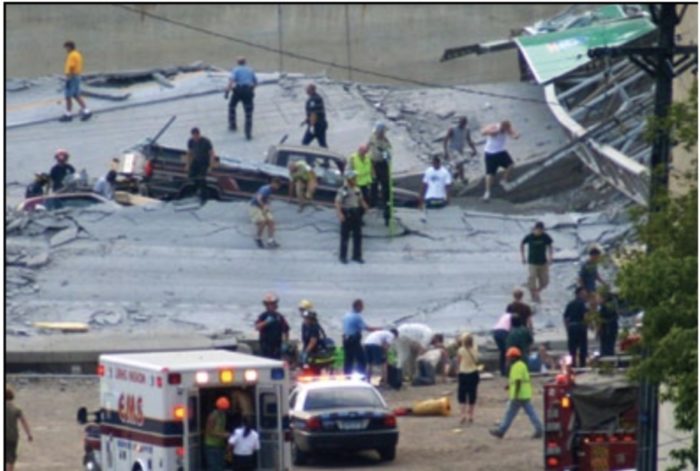We have another story to share with you from the “Minneapolis Police 150th Anniversary” book published by Acclaim Press (currently out of print).
It is a story from Retired Chief Tim Dolan about the collapse of the 35-W Bridge on August 1, 2007.
In the words of Retired Chief Dolan:
“When things are quiet, officers know they are always just one call away from earning their pay and maybe a whole lot more. On those calls they’ll be running towards dangers that most people flee. August 1, 2007, was one those days. Minnesota public safety was severely tested and they excelled.
August 1st is in the middle of the ‘Dog Days’ of a Minnesota summer. This day was “sticky.” Once you began perspiring, you couldn’t get dry. At about 6:05 p.m., the Interstate 35W bridge in Minneapolis fell into the Mississippi River.
35W is a main traffic artery in the Twin City metro area of nearly four million residents. Its Mississippi bridge is the third busiest in Minnesota, and its eight lanes handled an estimated hundred forty thousand vehicles a day as drivers drove to, out of, and around downtown Minneapolis. Sergeant Ed “E.T.” Nelson, of the downtown’s 1st Precinct, heard dispatch make the first notification. He asked that the call be repeated. The dispatcher did so and noted that they have received several more calls. Soon dispatch “toned” all radio channels signaling a citywide alert. All available police, fire and emergency medical personnel services were to respond immediately.
Eventually, Minneapolis Emergency Communications issued a full callback of all personnel – one of the few in the history of the Minneapolis Police and Fire Departments. One hundred and ninety people, 110 vehicles, fell about 100 feet with the bridge into the river and onto its banks. The victims included a paving crew who were working on bridge deck repairs and a school bus with sixty-three children and nine adults who returning home from a swimming outing. The bus was balanced on a huge slab of concrete hanging over the west bank of the river. A second faster and all would have crushed by another huge collapsing panel of the bridge. A second or two slower and the bus would have fallen into the Mississippi.
Sergeant Nelson was one the very first to arrive at the scene. He found a quarter mile long scene that was only accessible by foot from either of the two riverbanks. The bridge was still out of the water in most places. Responders on the west side had to traverse an open swelling part of the river by sitting on a sit beam and inching over open water to make it to victims. They did so as the bridge was still settling. Those following found an eerie scene of gun belts lying on the ground and looped over a fallen beam.
The other side of the river was just as hazardous. The bridge fell on top of some railroad tankers designated to be carrying hazardous materials. Nearby, a U of M research facility housed a nuclear reactor. There were initial fears of possible damage due to the bridge’s ground shaking impact. Rescuers arrived from everywhere. Over fifty police agencies responded. FBI Agents directed traffic. St. Paul Police answered Minneapolis calls for service. Everyone came to help, and they were all needed. Police, Fire and EMS quickly began to triage the one hundred and ninety victims. One hundred and forty-five needed treatment. At least fifty were hospitalized in at least three different hospitals.
Five victims were found dead that first day. It was unknown how many were trapped under the bridge. Dramatic pictures of the scene show officers holding ropes to assist firefighters diving in the water with rescue gear. In a seemly short amount of time, about an hour and a half, the bridge collapse scene had changed from a rescue to a recovery. It was not known yet if the bridge fell from natural causes or a terrorist act.
From then on, the MPD organized and directed overall recovery, investigations, media, security for the collapse site and outreach to victims’ families.
On Saturday, August 4th, President George Bush arrived at the bridge site and met with Federal, State and City leaders. At the meeting, I made an official request for the United States Navy’s Sea Air and Land (SEAL) divers to attempt to recover the remain- ing victims trapped under the bridge. The effort was much too difficult and dangerous for Hennepin County divers. President Bush granted the request. After two weeks of diving amid and under concrete slabs, through twisted metal, and in gasoline and oil filled water the SEALS recovered the remaining eight missing victims. They had to use air hoses to maneuver in the wreckage. Visibility was inches. They reported it as being the most difficult diving tasks in their history.
During the weeks that the SEAL divers needed to recover the victims, the Minneapolis Police Chaplain Corps, lead by Chaplain Jeff Stewart, hosted a “Family Center” at a nearby Holiday Inn. Assisted by the Red Cross and members of the Minneapolis Health Department the chaplains did the difficult job of consoling and updating family members of the recovery efforts. The Minneapolis Police Chaplain Corp’s efforts were cited and commended by many, but the most memorable thank you was likely the standing ovation they received from surviving family members at the opening ceremony for the 35W Memorial.
I used to tell officers that in policing, “we are only as good as we are today.” On August 1st, Minnesota public safety providers were nothing short of superb. The Minneapolis Police Department then ensured that on-going efforts would not diminish. There were many individual and department commendations. The highest were the Minnesota Police Chief’s Medal of Honor and the United States Senate’s esteemed “National Service Award.”
